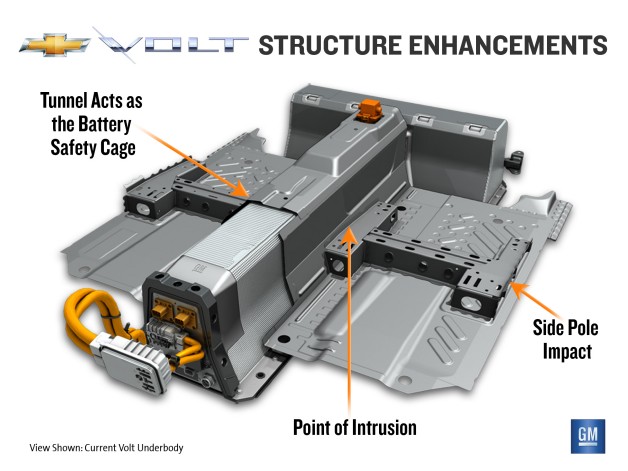- Thread starter
- Staff
- #21
- 55,563
- 23,827
Volt Battery Redesign Potentially Coming From GM
The National Highway Traffic Safety Administration has issued a statement on its investigation into aChevrolet Volt fire that occurred at the organization's facilities. NHTSA had done a side-impact test on a Volt then parked it outside, and three weeks later Chevy's plug-in hybrid caught fire. The battery was determined to be the cause, after its coolant line was ruptured during the side-impact test. That led the NHTSA to consider a ruling forcing hybrid and electric-car batteries to be drained after a wreck.
On Friday, NHTSA said it is opening "a formal safety defect investigation" to study the risks of fire in Chevy Volts that have been in major accidents. To be clear, though, the larger story is that this isn't just about the Volt, this is about any vehicle with a battery pack, with NHTSA gathering "additional information about the potential for fire in electric vehicles involved in a crash...."
NHTSA conducted three more tests on the Volt's battery packs over three days, each test involving damaging the pack and rotating the car to simulate an accident and rollover. The battery pack in the third test began to smoke and spark almost immediately, the pack in the second test caught fire a week later. It is due to these results that the formal investigation has been opened. Follow the jump for NHTSA's complete statement.
The National Highway Traffic Safety Administration has issued a statement on its investigation into aChevrolet Volt fire that occurred at the organization's facilities. NHTSA had done a side-impact test on a Volt then parked it outside, and three weeks later Chevy's plug-in hybrid caught fire. The battery was determined to be the cause, after its coolant line was ruptured during the side-impact test. That led the NHTSA to consider a ruling forcing hybrid and electric-car batteries to be drained after a wreck.
On Friday, NHTSA said it is opening "a formal safety defect investigation" to study the risks of fire in Chevy Volts that have been in major accidents. To be clear, though, the larger story is that this isn't just about the Volt, this is about any vehicle with a battery pack, with NHTSA gathering "additional information about the potential for fire in electric vehicles involved in a crash...."
NHTSA conducted three more tests on the Volt's battery packs over three days, each test involving damaging the pack and rotating the car to simulate an accident and rollover. The battery pack in the third test began to smoke and spark almost immediately, the pack in the second test caught fire a week later. It is due to these results that the formal investigation has been opened. Follow the jump for NHTSA's complete statement.


 I guess once it is proven that an EV burns down a house due to the cord(eventhough they are already melting outlets) then they will start to put regulations on the cords....
I guess once it is proven that an EV burns down a house due to the cord(eventhough they are already melting outlets) then they will start to put regulations on the cords....